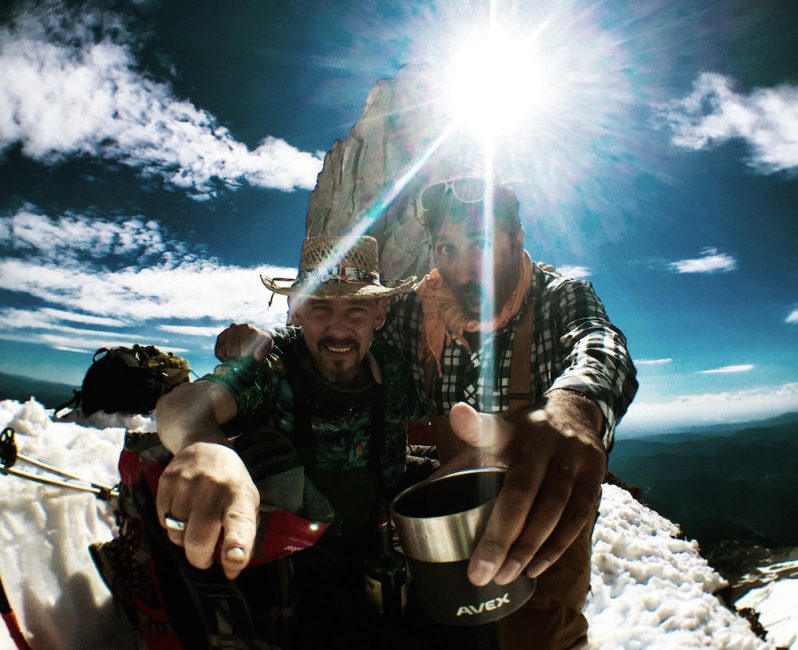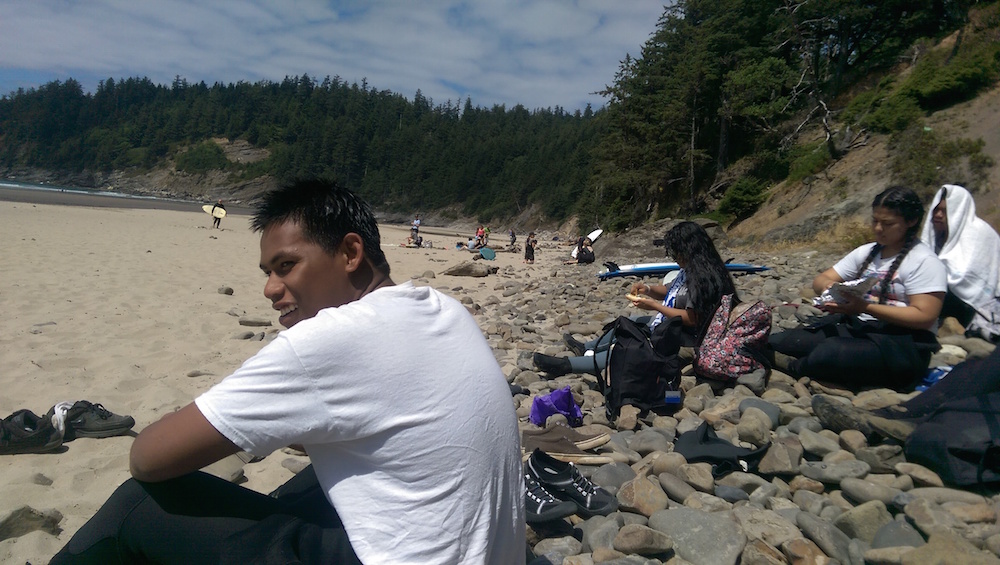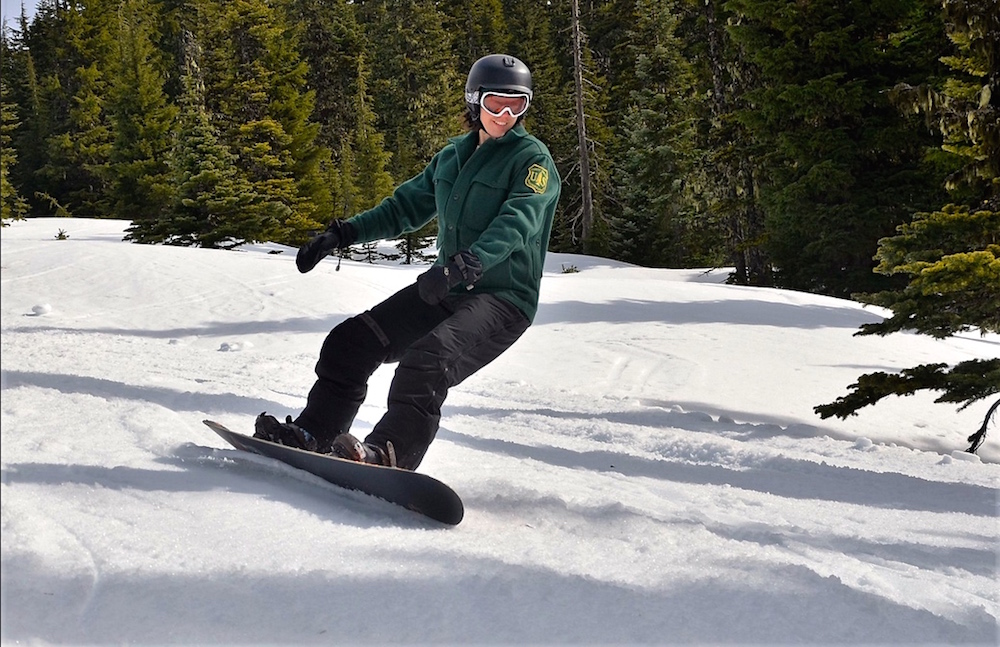It’s Friday morning at the Next Adventure tune shop, and Greg Coulter and his team are cranking through one pair of skis after another, drilling holes, tweaking bindings, grinding bases, working their way through a big backlog now that the snow has returned to Mount Hood and the floodgates have opened.
Hard-driving music pulses through the basement speakers and a walkie-talkie crackles with the occasional news flash: “Got a gentleman up here with a change of mind about a pair of bindings…” BEEP “Caller has wax on her hands, is wondering how she can get it off.”
“Wait… Whaaat?”
The Next Adventure atmosphere is loose but intense, a microcosm of Portland’s outdoor adventure culture. A lot of joking around, a lot of camaraderie, but also a lot of skilled labor: the grinding wheels keep spinning, and the backlog of skis gradually shrinks. Staffers query Coulter about prices, binding widths, settings and other technicalities, and he answers each question with quick confidence: 75 millimeters, 50 bucks. When it comes to skis, boots, and bindings, he seems to know just about everything.
Coulter, a wiry-strong 47-year-old master boot-fitter, was recruited last season to manage the tune shop at Next Adventure in Portland’s Central Eastside after a short stint at the Mountain Shop and a much longer stint at Hillcrest Ski & Sports. He’s been in the snow sports business for 30 years, and he is well known around Mount Hood and beyond as a crazy-fast skier, a live-wire character and a deeply dedicated boot and ski artisan. He is an official boot-tester for Ski and Skiing Magazines and a certified pacesetter for NASTAR races, and he has worked with top-tier athletes like Dew Tour Champ Nick Goepper, freeskiing stars Alex Hackell and Alex Beaulieu-Marchand, and three-time Paralympic medalist Mac Marcoux.
“Greg is one of the best boot-fitters in the country,” says Mount Hood racer Jay Pollock. “He cares about his clients and making sure no matter how long it takes things are done right. He’s the kind of guy that bends over backwards for his friends and clients.”
“Greg is the man,” adds ski mountaineer Asit Rathod, pictured with Coulter below. “He is extremely humble, but he is very good at what he does and very passionate about it. I just leave my stuff with him and I know he’s got it.”
Rathod and Coulter are long-time collaborators on the Summer Solstice shenanigans up on Illumination Saddle, an annual celebration of wilderness and wildness. “Greg definitely likes to have fun,” says Asit. “He’s hilarious, and he’s about as good a skier as you’ll find.”
A New Home at Next
Coulter got into the ski industry as a teenager. His best friend’s uncle was the manager at the Mountain Shop and got him a job there. He went on to work at Mogul Mouse and Larry’s, two of the many Portland ski shops to go under since the 1980s.
There used to be eight Mogul Mouse stores back in the day, but they’ve gone the way the Ski Chalet, Bob’s and so many others as the ski industry has evolved and shifted more and more business to the low-price Internet. Ski shops in Portland and beyond have had to adapt, and Next Adventure has proved one of the more flexible success stories, with its bargain basement, its buying of second-hand gear, its low prices throughout the store and online, and its solid reputation in the local community.
That local reputation got a boost with the hiring of Coulter. He works with a team of seven certified as boot fitters, and he says he is impressed with the Next Adventure crew, and with the spirit of the place.
“The employees here tend to be very unassuming, but their knowledge is amazing,” he says. “And they participate in all these sports. We’ve got world-class climbers, amazing paddlers, super-passionate skiers… Plus, it’s just a crazy fun place. Everybody is happy to be here, happy to have a job, stoked to do what they do. It’s an incredibly positive environment.”
Fellow tune shop employees such as Will Doud-Martin, a recent transplant from California, Monica Erickson, a skier from from Colorado, split boarder Drew Rupp, and longtime racer Phil Violet from Bend keep the atmosphere loose as they work their way through one set-up after another, about 50 pairs of skis per day when it’s busy.
Will Doud-Martin
Monica Erickson
A significant amount of the shop work involves mounting and tuning skis bought online and brought into the shop. “Online retail is a fact of life that’s here to stay,” Coulter says. “We sell online too. But even when somebody buys online, they still need to come in for mounting and tuning, and once they’re in the shop they usually spend some money. There are guys who try to mount their skis at home by themselves. When it’s done incorrectly it can be quite scary.”
‘The same level of energy in and out’
Boot work is less common but more specialized and pricey, since it is inherently customized to account for the nuances of each individual skier’s foot. This has been Coulter’s area of expertise for a long time, along with high-performance race tuning. He builds custom food beds and uses heat, pressure and grinding to improve the boot’s fit and performance, and to eliminate hot spots and foot numbness. Each winter he travels to test boots for Ski and Skiing Magazines and write up short magazine reviews judging comfort and performance.
“The boot is your most important piece of equipment,” he says. “A lot of people quit skiing because the boot isn’t working for them, but the thing is, a little work can make that boot work for them.
If it’s comfortable and you can flex it, great. Chances are you’re in good shape. If you have a boot that is pinching or binding or too stiff, that leads to the whole Pandora’s box of problems. Too stiff, you’re going to be in the back seat. You can’t physically flex it forward, so psychologically you search for stability and you get in the back seat because you’re afraid. It happens. We all do it. Your quads start burning because you are back on your haunches and you’re trying to ski off your heels. So yeah, a boot that you can flex, so you can keep your hips over your ankles, and then a good solid platform, a footbed. Everybody can benefit from a footbed. Get a boot that fits, and if you need some work done on it, do it. Punch out for that bunion, punch out for that ankle. Grind, stretch the plastic, so that the center mass of the knee is one degree over the inside of the boot line, the center line of the mold. You want your center of mass to be in there, so that your left turn is symetrical with your right turn. The same level of energy in and out. And that makes skiing seem almost easy because we’re putting the body into an efficient position rather than you trying to muscle the ski around… You just roll your ankles and your skis take over. That’s a perfect world. All you have to do is stand up a little bit, change ankle direction, and the ski comes over to the other side.
Sounds good to me. I have been working with Greg for a while now on custom-fitting a pair of high-performance but super-stiff Langes, and I can say that I appreciate his methodical approach. He works scientifically, trying things out, studying results, adjusting and adapting based on findings. It takes more effort and time than the “one-and-done” approach, but the results are worth it, especially when you’re talking about the difference between having to quit early and skiing comfortably all day with awesome response and performance from your boots and skis.
That’s the ethic that Coulter brings to his job building up the tuning and boot-fitting program at Next Adventure. He says his goal is always to leave things better than he found them: “Nothing makes me happier than having someone come in with boot problems, working with them to fix it, and then having them come in later with the problem solved.”
Last modified: January 26, 2016



